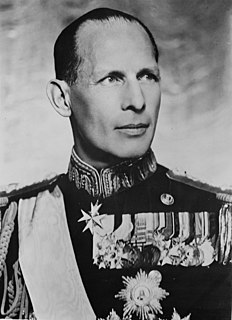
The Communist Party of Greece is a Marxist–Leninist political party in Greece. Founded in 1918 as the Socialist Labour Party of Greece, it is the oldest political party in modern Greek politics. The party played a significant role in the Greek resistance and its membership peaked in the mid-1940s. It was the instigator of the Greek Civil War, but ended on the losing side and was banned until 1974.
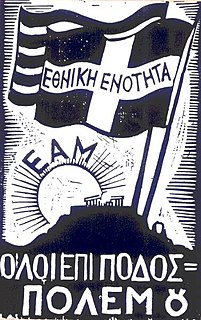
The National Liberation Front, commonly known by its acronym EAM, was the main movement of the Greek Resistance during the Axis occupation of Greece. Its main driving force was the Communist Party of Greece (KKE), but its membership throughout the occupation included several other leftist and republican groups. ΕΑΜ became the first true mass social movement in modern Greek history. Its military wing, the Greek People's Liberation Army (ELAS), quickly grew into the largest armed guerrilla force in the country, and the only one with nation-wide presence. At the same time, from late 1943 onwards, the political enmity between ΕΑΜ and rival resistance groups from the centre and right evolved into a virtual civil war, while its relationship with the British and the British-backed Greek government in exile was characterized by mutual mistrust, leading EAM to establish its own government, the Political Committee of National Liberation, in the areas it had liberated in spring 1944. Tensions were resolved provisionally in the Lebanon Conference in May 1944, when EAM agreed to enter the Greek government in exile under Georgios Papandreou. The organisation reached its peak after liberation in late 1944, when it controlled most of the country, before suffering a catastrophic military defeat against the British and the government forces in the Dekemvriana clashes. This marked the beginning of its gradual decline, the disarmament of ELAS, and the open persecution of its members during the "White Terror", leading eventually to the outbreak of the Greek Civil War.
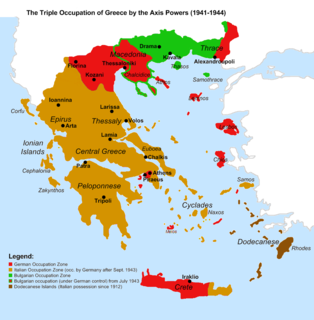
The Greek Resistance is the blanket term for a number of armed and unarmed groups from across the political spectrum that resisted the Axis occupation of Greece in the period 1941–1944, during World War II. It is considered as one of the strongest resistance movements in Nazi-occupied Europe.
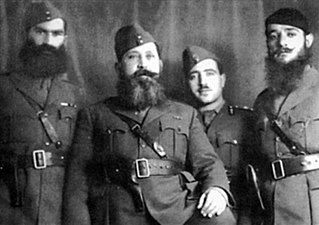
The National Republican Greek League or EDES was one of the major resistance groups formed during the Axis Occupation of Greece during World War II.
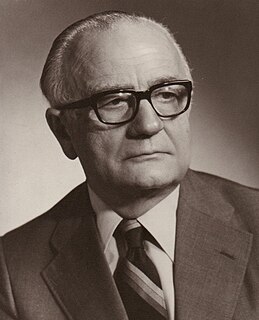
Parliamentary elections were held in Greece on 17 November 1974. They were the first after the end of the Greek military junta of 1967–1974 and took place during the metapolitefsi era. The winner was Konstantinos Karamanlis and his newly formed conservative party, ND. Karamanlis had already formed a government of national unity just after the fall of the dictatorship. The second biggest party was the centrist Center Union - New Forces. Third power in the Parliament became the newly formed PASOK, a radical socialist party led by Andreas Papandreou, son of the former prime minister Georgios Papandreou.
A referendum on restoring the monarchy was held in Greece on 3 November 1935. The proposal was approved by 97.9% of voters.

Ioannis Rallis was the third and last collaborationist prime minister of Greece during the Axis occupation of Greece during World War II, holding office from 7 April 1943 to 12 October 1944, succeeding Konstantinos Logothetopoulos in the Nazi-controlled Greek puppet government in Athens.

Parliamentary elections were held in Greece on 31 March 1946. The result was a victory for the United Alignment of Nationalists, an alliance that included the People's Party, the National Liberal Party, the Reform Party, which won 206 of the 354 seats in Parliament. As a result Konstantinos Tsaldaris became Prime Minister leading a right-wing coalition. Nonetheless, he soon decided to resign in favor of Themistoklis Sophoulis, who led a government of national unity during the entire second phase of the civil war (1946–1949). One of the priorities of the new government was the proclamation of a plebiscite for the restoration of the Greek monarchy.

Themistoklis Sofoulis or Sophoulis was a prominent centrist Greek politician from Samos Island, who served three times as Prime Minister of Greece, belonging to the centre-left wing of the Liberal Party, which he led for many years.

The Security Battalions (Greek: Τάγματα Ασφαλείας, translit. Tagmata Asfaleias, derisively known as Germanotsoliades or Tagmatasfalites were Greek collaborationist military groups, formed during the Axis occupation of Greece during World War II in order to support the German occupation troops.

Napoleon Zervas was a Greek general and resistance leader during World War II. He organized and led the National Republican Greek League (EDES), the second most significant, in terms of size and activity, resistance organization against the Axis Occupation of Greece.
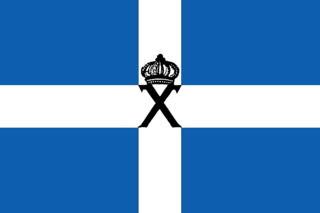
The Organization X was a fighting force and resistance organization with a firm right-wing and royalist ideology right set up during the Axis occupation of Greece, in June 1941 as a resistance organization. Initially, the group's name was Grivas Military Organization and in March 1943 it was renamed, adopting George's II royal monogram of two crossed gammas which resembled the Greek alphabet chi (X). X was heavily involved in battles against EAM and its secret police, OPLA, after the Axis occupation and during the civil war, considered communism to be its principal enemy.
Georgios Kartalis was a Greek politician.

Τhe Greek Civil War was fought in Greece from 1946 to 1949 between the Greek government army — backed by the United Kingdom and the United States — and the Democratic Army of Greece (DSE) — the military branch of the Communist Party of Greece (KKE) — backed by Yugoslavia and Albania as well as by Bulgaria. It is often considered the first proxy war of the Cold War, although the Soviet Union avoided sending aid. The fighting resulted in the defeat of the DSE by the Hellenic Army. Founded by the Communist Party of Greece and supported by neighboring and newly founded Socialist States such as Yugoslavia, Albania and Bulgaria, the Democratic Army of Greece included many personnel who had fought as partisans against German, Italian and Bulgarian occupation forces during the Second World War of 1939–1945.
The Feneos Executions is the name given to a series of killings committed by the Greek People's Liberation Army (ELAS) resistance group, and especially by its secret police OPLA, in the Feneos area of Corinthia, Greece, during the very first stages of the Greek Civil War, while the country was still occupied by the Axis Powers.
The Lebanon conference was held on May 17–20, 1944, between representatives of the Greek government in exile, the pre-war Greek political parties, and the major Greek Resistance organizations, with the British ambassador Reginald Leeper in attendance. The conference occurred after an anti-monarchist mutiny among the Greek military the previous month. Prime Minister Georgios Papandreou was unable to reconcile communist and anti-communist political factions.
The Panhellenic Liberation Organization, was a Greek undercover resistance organization against the Axis occupation of Greece. It was founded in 1941 by a group of Greek army officers, under the name Defenders of Northern Greece, employing methods of non violent resistance. In 1943, YVE was renamed as the Panhellenic Liberation Organization (PAO), shifting its focus towards armed struggle. In the August of the same year it came into conflict with Greek People's Liberation Army (ELAS), a communist-led resistance organization. PAO was defeated in the ensuing civil war and its remnants turned towards collaboration with the Germans.



